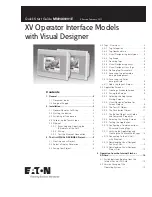
13
Quick Start Guide
MN0480001E
Effective February 2011
XV Operator Interface Models
with Visual Designer
eaton Corporation
www.eaton.com
Next click on the “0” shown in the Counter
Value and the pop-up Virtual Keyboard will
be displayed as shown:
Click on the numbers on the keypad then
click the green “check” button to enter the
value. The black “left arrow” button is the
backspace key and the red “x” button is a
clear key. Once the value is entered the
Virtual Keypad will disappear and the value
entered will be shown on the screen.
Once you’ve finished testing your application <ALT> tab back to the
editor and close the runtime by clicking the Stop Application
icon on the Ribbon’s Home tab.
3.5.10 Configuring a Communications Driver and
Linking Tags
To tie the Visual Designer application to data in a PLC, communica-
tions device, or the built-in PLC of the unit you need to configure a
driver. To do so, go to the Comm tab in Project Explorer, right-click
on the Drivers folder and choose “Add/Remove drivers” as shown.
In the resultant “Communications Drivers” dialog all drivers will be
displayed as shown. Scroll down until you have found the driver you
want to add, click on the driver and then click the “Select>>” but-
ton. Then click “OK”. For purposes of this manual we will use the
Eaton protocol labelled MODBUS EATON Protocol RTU/ASCII (CE)
[v1.1]. This protocol is used to communicate with Eaton’s ELC family
of programmable controller which support both Modbus serial and
Modbus TCP protocols.
Next configure the Driver Settings by first clicking on the Drivers
folder then expanding the folder and right-clicking on the specific
driver. Then select “Settings” as shown.
In the Driver Settings dialog use the drop list (as shown) to select
either a serial or TCP/IP connection, ASCII or RTU Protocol, and if
using a serial connection set the Serial Port parameters to match the
PLC’s serial port settings. When finished click “OK”.
Next, under the PLC in the Comm workspace, double-click on the
Main Driver Sheet to open up its dialog as shown.
In the Main Driver Sheet all tags which are to be read from the
communications device must be entered and assigned a Station
and I/O Address. The Action field should be set appropriately as
“Read+Write”, or “Read” or “Write” only. Tags which are used for
background tasks such as alarming, trending, and data archiving
should leave the Scan field set to “Always”. Those tags which are
used for screen display and control only should have the Scan field
changed to “Screen”.
















